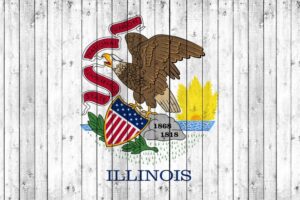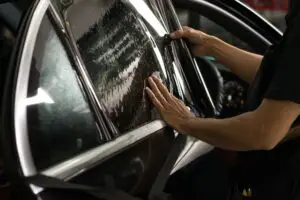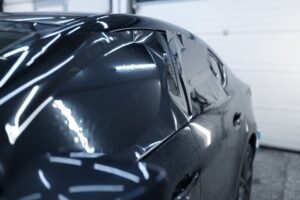While most of the laws and regulations set by other states are fairly straightforward, some states, like the state of Illinois, have a lot of additional rules that you need to worry about.
Illinois window tint laws say that you cannot have reflective tints on your windshields and that they must be limited to the top 6 inches.
All sedan windows need at least 35%, while some for Sports Utility Vehicles and vans need at least 50% VLT and others do not have any such restrictions.
These rules are only the tip of the iceberg when it comes to Illinois, which is why I will be explaining all of the laws, rules, and regulations the state has when it comes to window tinting.
Table of Contents
- 1 How Much Tint Darkness Is Legal In Illinois?
- 2 Window Tint Reflection And Tint Colors
- 3 Medical Exemption Of Window Tint Laws In Illinois
- 4 Get A Certified Sticker From The Company
- 5 Other Window Tint Law Rules And Regulations In Illinois
- 6 Cost Of Car Window Tint In Illinois
- 7 Frequently Asked Questions
- 8 Conclusion
How Much Tint Darkness Is Legal In Illinois?

For the most part, you should try and retain 50% VLT for all cars and vehicles in Illinois.
While for vehicles like sedans, you can go lower, if you follow the 50% rule, you should be good regardless of your vehicle’s body type.
Tint Darkness Limit For SUVs And Vans
Starting with sports utility vehicles and vans, their windshield cannot have any sort of reflective tints at all. Any tints they have must be on the top 6 inches of the windshield.
Moving on to the front seat side windows, they require 50% VLT. Any lower, and you risk getting in trouble with the police.
For the back seat side windows, this restriction is not present.
No restriction is present at all, meaning that you can choose whatever darkness you want for the tints of the back seat side windows.
This trend also follows through to the rear windows, which can have whatever VLT you see fit.
Aside from all of these laws specific to sports utility vehicles and vans, various other laws apply to all cars in general, which I will go over later in the article, so make sure to read it all.
Tint Darkness Limit For Sedans
For now, I should talk about the rules that Illinois has imposed on sedans and what sedan owners have to face.
1. Front Windshield
Windshields must use a nonreflective tint if you are thinking of applying one on the windshield, and if you do start to apply one, it can only be on the first 6 inches of the screen. This rule is the same as it is for SUVs and vans.
2. Front Seat Side Windows
Immediately you can see that for sedans, things are much less restricted as the front seat side windows need at least 35% of light to pass through.
This might make you think tinting windows in Sedans is easier, but as you will see, this is not the case.
3. Rear Window
Here is where things start to deviate from SUVs and vans severely.
Sedans are also required to have their rear windows allow 35% light to enter into the vehicle, losing the idea of no restrictions for SUV owners.
4. Back Seat Side Windows
The same is the case for the back seat side windows, which also have a 35% VLT requirement to be street legal.
Window Tint Reflection And Tint Colors
- Illinois says that any tints applied to the windows should be nonreflective.
- While the state is not clear on what this means, people can infer that it means that metallic or mirror tints should be avoided.
- This rule applies to the front seat side windows and the back seat side windows.
- The state of Illinois imposes no color restrictions.
- People can use whatever color they want for their window tints and will not be breaking any rules.
Medical Exemption Of Window Tint Laws In Illinois

Many people suffer from various conditions and illnesses that cannot stay in the sun.
This means that they will have to have much darker tints to drive from one place to another.
While many different states do not allow any medical exemptions, the state of Illinois offers medical exemptions to the people who can prove that they are suffering from actual conditions.
This can be done by requesting a certified letter or a statement from a licensed physician.
This letter must prove that you are suffering from a condition that requires you to be medically exempt.
This will help you get special tints for your windows and prevent you from getting in any trouble.
Get A Certified Sticker From The Company
To further increase the convenience of the people, the state of Illinois has not made it any sort of requirement for the owner of the car or the manufacturer of the window tint films to have any sort of certification related to the legality of the tint.
Many states often require this in the form of a certificate or a sticker that must be placed between the window and the film; however, this is not the case in Illinois.
You do not have to identify if your tint is legal or not; however, if you are pulled over, it must be street legal otherwise, there may be repercussions.
Other Window Tint Law Rules And Regulations In Illinois
Finally, getting to the other laws, here are the few laws that make the Illinois window tint laws difficult to remember and execute:
- If the front seat side windows are not tinted, any windows behind the driver can have any tint or darkness they want.
- As long as the windows behind the driver are not tinted below 30% VLT, the vehicle owner can opt to tint their front-seat side windows with a 50% tint.
- If your vehicle has window tints on its back seat side windows that are factory-installed, the front seat side windows must have a tint of over 50% VLT.
- You are not required to have any form of certification to show the legality of your window tints.
- You can have any color tints you want.
- You can use special tints if you are medically exempt.
- The state has a tint variance of 5%, which means that if you are within 5% of the window tint requirement, you will not be breaking the law.
Cost Of Car Window Tint In Illinois
Car window tints can cost anywhere between $50 to $800 in Illinois. This will no doubt depend on the tint you want to apply.
Basic tints that are non-reflective can start at $50 and go up to $600. If you are looking for premium tints, you will need to pay anywhere between $100 and $800.
Frequently Asked Questions
Q1. Is 15% Tint Legal In Illinois?
15% tints can be legal in Illinois if used in the correct configuration and on the correct windows, as stated above in the article.
Q2. Are 5% Tints Legal In Illinois?
Same as the question above, if you use this tint on certain vehicles and windows, you can get away with 5% tints; however, if used in the wrong configuration, they can easily be illegal.
Q3. Is Limo Tint Legal In Illinois?
Limo tints, if applied to the rear windows of SUVs, can be legal, but for the most part, you should avoid them and generally stick to 50% VLT tints.
Q4. Can I Get Pulled Over For Tint In Illinois?
You can easily get pulled over for your window tint in Illinois. This will carry a very heavy fine if you are caught breaking the law.
Q5. How Much Is A Tint Ticket In Illinois?
If you are caught the first time, you can be slapped with a fine ranging from $50 to $500. If you are caught again, the fine will be bumped to $100 to $500, where it will stay.
Conclusion
People were right when they said that the Illinois window tint laws are extremely convoluted and difficult to follow.
You need to take care of so many different conditions and things if you want to follow the rules. The easiest way is to simply have all your windows above 50% VLT to avoid any hassle.
With that being said, the state of Illinois also offers a lot of convenience to the people in the form of medical exemptions, lack of certifications, and the 5% variance, which is a generous buffer that many people can appreciate.

I am Tahir Azam, and I have been writing amazing articles for TaxiHack for as long as I can remember. I know everything that is to know when it comes to automobiles and is always on top of industry news and developments. While I am not an expert by any means, I pride myself on knowing the ins and outs of many different problems and, of course, their solutions. The articles on our website are some of the best and well-researched content that you will find, and I spend countless hours making sure this remains to be true. This is why I ask you to take your time out and read some of my articles, especially if you find a topic that resonates with you or is something you are looking into. This way, you will find the perfect mix of information and tips on your desired topic. Learn more about Tahir.




